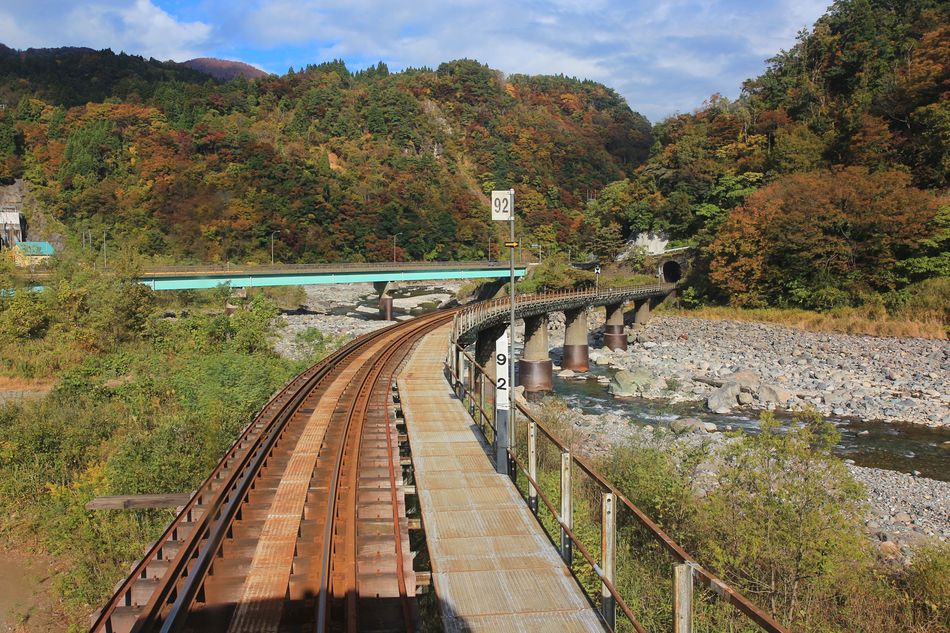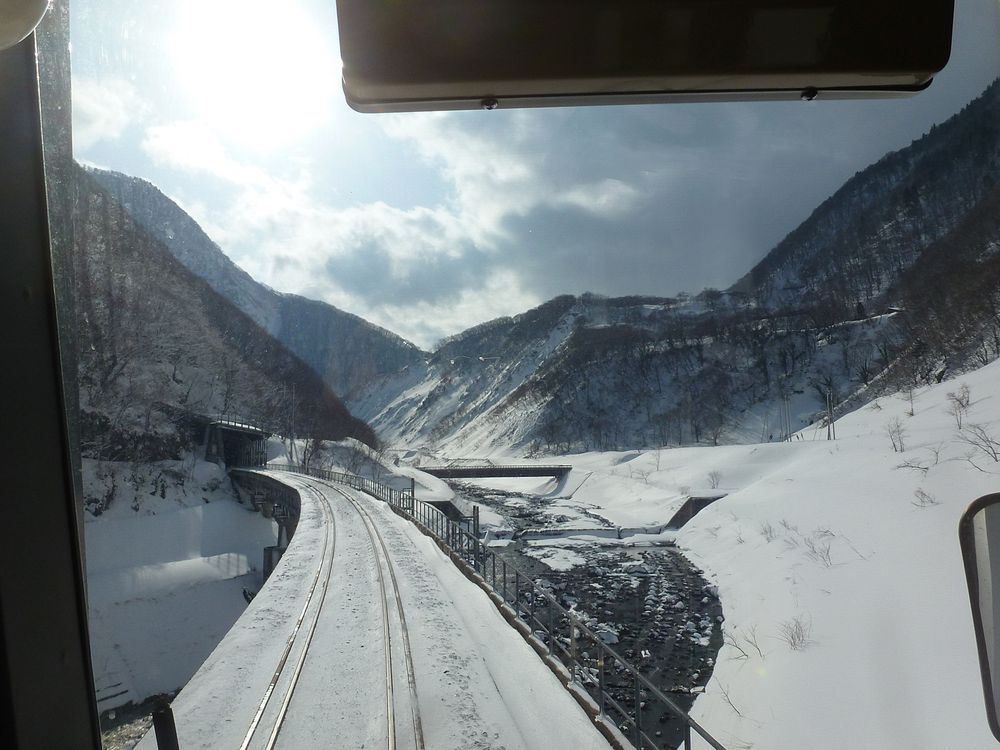Ôito-sen (Minami Otari – Itoigawa, operated by JR West Japan) 大糸線 JR 西日本

3329 KIHA 120 329 between Nakatsuchi and Minami Otari. (2018)

The name of the line refers to two localities: Ômachi 大町 (known as Shinano* Ômachi 信濃大町), and Itoigawa (糸魚川). The two characters 大 and 糸 together are read "Ôito".
The Ôito-sen has an overall length of 105, 4 km. The starting point is the town of Matsumoto (592 m above sea level), located in the Matsumoto Basin in the centre of Nagano Prefecture and surrounded by spectacular mountains. Running northwards towards the Japan Sea the line soon follows the Takasegawa River, arriving at Shinano Ômachi after a run of 35, 1 km. From here on the Ôita-sen crosses the watershed and the pass with its beautiful lakes (Yanaba station is around 822 m high). Then begins the steep descent along the Himekawa River towards the Japan Sea. On the west side of the line peaks of the Hakuba mountain range rise to almost 3000 m. At Minami Otari the electrified section (DC 1500 V) of the Ôita-sen ends, and with it the services of JR East Japan. Minami Otari lies at an altitude of about 525 m, and apart from local services from Matsumoto it is also served by at least one express from Tokyo (Shinjuku) per day.
The railway line this far was built into the Shinano Ômachi region in 1915/16, and from here on past Minami Otari down the valley to Nakatsuchi between 1929 and 1935. Electrification to Minami Otari was completed in 1967. Minami Otari is 70, 1 km from Matsumoto in the south, and 35, 3 km into the mountains from Itoigawa and the Japan Sea in the north.
The section today operated by JR West Japan (i.e. Minami Otari to Itoigawa) is not electrified; the line is characterised by very tight curvature and partly steep gradients as it threads its way along the Himekawa River and through numerous tunnels (the longest measures 3125 m) and many snow and avalanche sheds. As mentioned, as far as Nakatsuchi (31, 3 km from Itoigawa) the line was in use by 1935, but beyond the extremely difficult terrain prevented further development northwards at the time.
From the north at Itoigawa the Ôito-sen took shape southwards as far as Kotaki (13, 6 km, about 133 m above sea level) in 1935. However, the intermediate section from Kotaki to Nakatsuchi (about 462 m above sea level) was only completed in 1957, from when on the Ôito-sen could be traversed in its entire length.
The line between Itoigawa and Minami Otari has been seriously hit several times by natural disaster, landslides, severe flooding and torn-away embankments; from July 1995 to the end of November 1997 no through trains could operate between Hakuba (JR East section) and, at first, Nechi (10 km from Itoigawa), then Kotaki (13, 6 km from Itoigawa). Winter services were interrupted from January to March 2006 and February to April 2012. Services were again suspended June to August 2013 due to damaged river embankments, and the violent earthquake in November 2014 prevented trains to run for over a month.
The 2019 timetable sees 7 stopping trains per day Itoigawa - Minami Otari and back, and two more trains from Itoigawa as far as Hiraiwa.
The future of the line is not secure. As of 2022 discussions about JR West's local lines are taking place, the outcome of which are not yet clear.
* The old province name of Shinano corresponds more or less to present-day Nagano Prefecture.

2702 KIHA 120 341 on an Ôito-sen working has come down from Minami Otari and is entering Itoigawa, dwarfed by the Hokuriku Shinkansen and the Shinkansen Itoigawa station. (2018)

2713 Ôito-sen KIHA 120 341 at Itoigawa 糸魚川 station waiting for passengers in direction of Minami Otari. (2018)

2796 Inside KIHA 120 341. (2018)

0399 From Itoigawa to Himekawa: Shortly after leaving Itoigawa the Ôito-sen cuts through a first range of hills. (2013)

3476 From Itoigawa to Himekawa: The cement factory and waste heat recovery power station at Himekawa. (2018) s

0402 From Itoigawa to Himekawa: Himekawa 姫川 halt, with KIHA 120 354 in the mirror. (2013) s

3473 From Himekawa to Kubiki Ôno. (2018)

3468 From Himekawa to Kubiki Ôno: Kubiki Ôno, looking southwards. (2018) s

0411 From Himekawa to Kubiki Ôno: Kubiki Ôno, with KIHA 120 354 in the mirror. (2013) s

2728 From Kubiki Ôno to Nechi: Kubiki Ôno, looking northwards, out of the rear of the train. (2018) n

3460 From Kubiki Ôno 頸城大野 to Nechi 根知. (2018)

3455 From Kubiki Ôno to Nechi. (2018)

0426 From Kubiki Ôno to Nechi: Entering Nechi station. Looking southwards. (2013) s

0445 From Kubiki Ôno to Nechi: KIHA 120 341 and KIHA 120 329 entering Nechi station. (2013) s

3447 From Kubiki Ôno to Nechi: KIHA 120 341 at Nechi 根知 , heading for Minami Otari. (2018) s

2742 From Nechi to Kotaki: Along the Himekawa River. Looking northwards, out of the rear of the train. (2018)

2744 Between Nechi and Kotaki. Looking northwards, out of the rear of the train. (2018) n

3430 Between Nechi and Kotaki. Looking southwards. (2018) s

0452 Between Nechi and Kotaki. (2013) s

2747 From Nechi to Kotaki: Just below Kotaki, coming up from Nechi. Looking northwards, out of the rear of the train. (2018)

0459 The power station at Kotaki. Looking southwards. (2013) s

0469 From Nechi to Kotaki: Kotaki, with KIHA 120 354 in the mirror. (2013)

2754 From Kotaki 小滝 to Hiraiwa: Looking northwards, out of the rear of the train. (2018)

3413 From Kotaki to Hiraiwa. (2018)

3410 From Kotaki to Hiraiwa. (2018)

2758 Crossing the river, between Kotaki and Hiraiwa. Looking northwards, out of the rear of the train. (2018) n

3405 Between Kotaki and Hiraiwa. (2018)

0475 Between Kotaki and Hiraiwa. Winter scene. (2013) s

0477 In the gorge between Kotaki and Hiraiwa. (2013) s

2762 In the gorge between Kotaki and Hiraiwa. (2018)

3398 Between Kotaki and Hiraiwa. (2018)

2768 Between Kotaki and Hiraiwa. Looking northwards from the rear of the train. (2018)

3400 Between Kotaki and Hiraiwa. (2018)

0485 Between Kotaki and Hiraiwa, looking southwards. (2013) s

0488 Between Kotaki and Hiraiwa, in the beauty of winter. (2013)

0494 Coming up to Hiraiwa. (2013) s

2787 Hiraiwa 平岩, from the rear of the train, looking northwards. (2018)

3390 Hiraiwa, with KIHA 120 341 in the mirror. (2018) s

0502 KIHA 120 354 in the mirror at Hiraiwa, with the big Buddha in the hills behind. (2013)

3379 From Hiraiwa to Kita Otari: Shortly after leaving Hiraiwa. (2018)

0512 From Hiraiwa to Kita Otari: Shortly after leaving Hiraiwa, in winter. (2013)

2804 From Hiraiwa to Kita Otari. Looking northwards from the rear of the train. (2018)

2808 From Hiraiwa to Kita Otari. Looking northwards from the rear of the train. (2018)

84 X 1 From Hiraiwa to Kita Otari. (1984) s

2812 From Hiraiwa to Kita Otari. Looking northwards from the rear of the train. (2018)

0517 Kita Otari in the depth of winter. (2013)

0524 Kita Otari 北小谷 . (2013)

0527 Looking across the valley between Kita Otari and Nakatsuchi. (2013)

2826 Between Kita Otari and Nakatsuchi. Looking northwards from the rear of the train. (2018)

2833 Between Kita Otari and Nakatsuchi. Looking northwards out of the back of the train. (2018)

3366 Between Kita Otari and Nakatsuchi. (2018)

2839 Nakatsuchi, with KIHA 120 341 in the mirror. Looking northwards from the rear of the train. (2018)

0536 Arriving at Nakatsuchi. (2013)

0543 Nakatsuchi 中土 . (2013)

2853 Between Nakatsuchi and Minami Otari, along the Himekawa River. Looking northwards to the rear of the train. (2018)

3338 Between Nakatsuchi and Minami Otari KIHA 120 329 runs along the Himekawa River. (2018)

2855 In the direction of Itoigawa just after leaving Minami Otari terminal a signpost indicates that the train is crossing the border between from JR East Japan to JR West Japan. (2018)

2856 Shortly before entering Minami Otari terminal, looking to the rear of the train down the valley. (2018)

2864 Minami Otari terminal. JR West KIHA 120 341 from Itoigawa stands alongside JR East electric unit 127-111 that will shortly leave for the run southwards along the foot of the Alps to Shinano Ômachi. (2018)

0560 Minami Otari 南小谷, with an electric JR East Japan unit from Shinano Ômachi on the right (unit 127-111), and a JR West Japan diesel car (KIHA 120 354) from Itoigawa on the left. (2013)

84-X-1 Minami Otari in 1984, with electric unit lead by KUHA 115-1223 and, to the left, the diesel train to Itoigawa, at that time a pair of class KIHA 58 coaches. On the far right is a class 183 express train for Tokyo. In 2022 there remains only one express connection to Tokyo, arriving at 11:59 and leaving 15:00.

3354 JR West Japan diesel car KIHA 120 329 ready to leave Minami Otari for Itoigawa. (2018)

